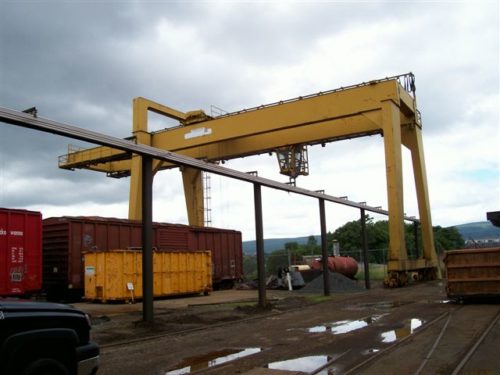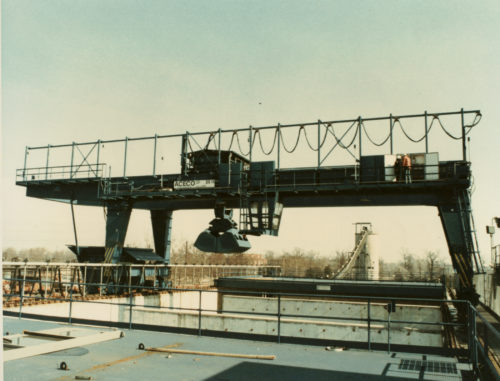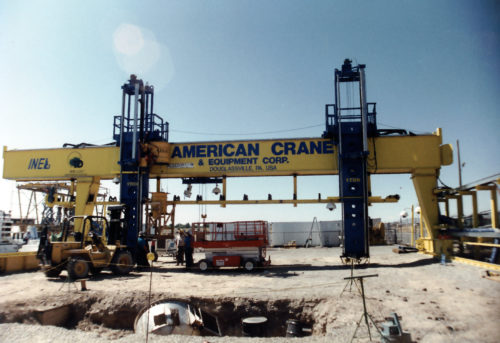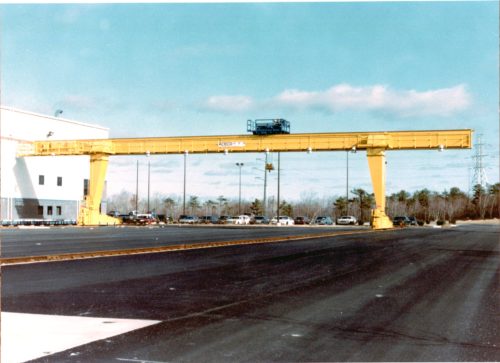 A gantry crane uses its own legs for support rather than a beam or other fixture within the facility. Indoor gantry cranes may have a single or multiple girders, with multiple girder models better suited to heavy-duty work. There are four primary styles of gantry crane, each suited to specific applications:
A gantry crane uses its own legs for support rather than a beam or other fixture within the facility. Indoor gantry cranes may have a single or multiple girders, with multiple girder models better suited to heavy-duty work. There are four primary styles of gantry crane, each suited to specific applications:
- Full gantry cranes.The most popular style, full gantry cranes have two legs that run along a track. That track is typically embedded into the work surface, so trucks, forklifts, and other vehicles can easily cross it.
- Semi gantry cranes.This type of gantry crane has one leg. The other side of the crane runs along a track on the wall to save space. Both full and semi gantry cranes are common in heavy-lift manufacturing applications.
- Portable gantry cranes.These cranes are fixed on wheels, allowing them to be moved throughout a facility and easily stored out of the way. Portable gantry cranes are best-suited for lighter lifting tasks. Portable gantry cranes are often used to hold a load so workers can easily access it for maintenance or modification. Portable gantry cranes have a myriad of uses in manufacturing and warehouse environments.
- Adjustable gantry cranes.Another light-duty option, adjustable cranes allow adjustment of the span or the height of the cranes to manage different types of loads. These cranes see frequent use in warehouses and in manufacturing environments with variable loads.
Primary Factors that Affect Gantry Crane Design
It’s important to choose the right crane for the job. Depending upon your application, you may require a custom gantry crane design. This ensures the crane suits its intended working conditions, facility layout, and load requirements. The following factors impact gantry design:
Arm and Span Length
When determining arm and span length, first consider the size of the work area and the size and weight of the maximum load. This is where gantry crane design begins. Determine how big the crane needs to be, and how much weight it must support or lift reliably.
Indoor or Outdoor Use
 The operating environment of the crane will determine the ideal materials and finishes used to fabricate its various components. Consider temperature extremes and fluctuations, weather exposure, and harsh operating conditions to help guide the selection of the proper materials and finishing processes.
The operating environment of the crane will determine the ideal materials and finishes used to fabricate its various components. Consider temperature extremes and fluctuations, weather exposure, and harsh operating conditions to help guide the selection of the proper materials and finishing processes.
Fixed or Rotating Axle End Trucks
Indoor cranes typically use fixed axle end trucks because they largely stay in one place. Outdoor cranes may need to move across yards where they can gather dirt and debris that will impact performance. Rotating axle end trucks have fewer parts and use lubrication to block dirt and debris.
Speed
Gantry cranes are versatile, cost-effective, and easy to maintain, but they move loads slowly. If speed is a priority within your operation, you may need to consider a different type of crane. Attempting to move a load more quickly than a gantry crane allows could cause an accident or damage the load or equipment.
Power Delivery
Cable reels are a common choice for supplying power, as the spring-loaded or motor-driven design can release and retrieve cable as you need it. Mounting the cable reel on a swivel provides an ability to work in multiple directions, but the downside is that the cable will sag when long lengths are in use. This may cause problems for foot and motor traffic on the ground. Custom solutions may include a series of poles and beams designed to keep wires off the ground. For portable gantry cranes, a longer extension cord may be sufficient, or it may be possible to simply position the crane closer to a power source.
Common Applications & Uses of Gantry Cranes
 Some indoor gantry crane models can lift up to five tons, making them useful in a range of applications such as shipyards, warehouses, manufacturing facilities, forges, and more. Gantry cranes offer versatility and reliability when lifting large and heavy components, raw materials, and heavy finished parts.
Some indoor gantry crane models can lift up to five tons, making them useful in a range of applications such as shipyards, warehouses, manufacturing facilities, forges, and more. Gantry cranes offer versatility and reliability when lifting large and heavy components, raw materials, and heavy finished parts.
Gantry Crane Design Standards
Like other heavy equipment, gantry design is based on specific standards for function and safety. These standards cover design, fabrication, material selection, and even painting.
The Operational Safety and Health Administration (OSHA) offers guidelines for the safe operation of gantry cranes. The American Society of Mechanical Engineers (ASME) provides guidelines for building gantry cranes, as does the American Welding Association (AWS). All cranes must comply with these standards.
When you work with a reputable crane supplier, you can trust your gantry crane design meets all regulations to keep your workplace OSHA compliant and your employees safe. All gantry cranes manufactured or sold by American Crane follow the requirements set forth by these organizations. We also adhere to the stringent quality requirements and standards of the Crane Manufacturers Association of America (CMAA) in duty classes A through F. We factory test all of our gantry cranes before we ship to the customer.
Indoor Lifting Solutions From American Crane
 American Crane is a leading manufacturer and distributor of cranes and hoists. Our quality assurance program meets the standards for the nuclear industry, and we offer an expansive range of customization options to tailor crane solutions to specific application environments. Our portfolio of gantry cranes includes:
American Crane is a leading manufacturer and distributor of cranes and hoists. Our quality assurance program meets the standards for the nuclear industry, and we offer an expansive range of customization options to tailor crane solutions to specific application environments. Our portfolio of gantry cranes includes:
- American Crane Custom Multiple Girder Gantry Cranes
- American Crane Custom Single Girder Gantry Cranes
- Gorbel Gantry Cranes
We can help you rebuild existing equipment or provide you with brand new solutions. We also offer load testing, upgrades, inspections, and an extensive parts catalog.
Contact us or request a quote to learn more about gantry crane design or how we can help you fully customize a gantry hoist to suits your needs.





